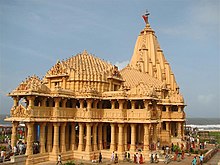Somanath
| Somnath temple | |
|---|---|

Front view of the present Somnath Temple
|
|
| Geography | |
| Coordinates | 20°53′16.9″N 70°24′5.0″E / 20.888028°N 70.401389°ECoordinates: 20°53′16.9″N 70°24′5.0″E / 20.888028°N 70.401389°E |
| Country | India |
| State | Gujarat |
| District | Gir Somnath |
| Locale | Prabhas Patan, Veraval |
| Culture | |
| Sanctum | Somnath (Shiva) |
| Important festivals | Maha Shivaratri |
| Architecture | |
| Architectural styles | Hindu temple architecture |
| History and governance | |
| Date built | 1951 (present structure) |
| Temple board | Shree Somnath Trust of Gujarat |
| Website | www |
The Somnath temple located in Prabhas Patan near Veraval in Saurashtra on the western coast of Gujarat, is believed to be the first among the twelve jyotirlinga shrines of Shiva. It is an important pilgrimage and tourist spot of Gujarat. Destroyed and reconstructed several times in the past, the present temple was reconstructed in Chaulukya style of Hindu temple architecture and completed in May 1951. The reconstruction was envisioned by Vallabhbhai Patel and was completed under K. M. Munshi, the then head of the temple trust.
The temple is considered sacred due to the various legends connected to it. Somnath means "Lord of the Soma", an epithet of Shiva.
The Somnath temple is known as "the Shrine Eternal", following a book of K. M. Munshi by this title and his narration of the temple's destruction and reconstruction many times in history.
According to tradition, the Shivalinga in Somnath is one of the twelve jyotirlingas in India, where Shiva is believed to have appeared as a fiery column of light. The jyotirlingas are taken as the supreme, undivided reality out of which Shiva partly appears.
Each of the twelve jyotirlinga sites take the name of a different manifestation of Shiva. At all these sites, the primary image is a lingam representing the beginning-less and endless stambha (pillar), symbolizing the infinite nature of Shiva. In addition to the one at Somnath, the others are at Varanasi, Rameswaram, Dwarka, etc.
The site of Somnath has been a pilgrimage site from ancient times on account of being a Triveni sangam (the confluence of three rivers — Kapila, Hiran and the mythical Sarasvati). Soma, the Moon god, is believed to have lost his lustre due to a curse, and he bathed in the Sarasvati River at this site to regain it. The result is the waxing and waning of the moon, no doubt an allusion to the waxing and waning of the tides at this sea shore location. The name of the town Prabhas, meaning lustre, as well as the alternative names Someshvar and Somnath ("The lord of the moon" or "the moon god") arise from this tradition.
...
Wikipedia

